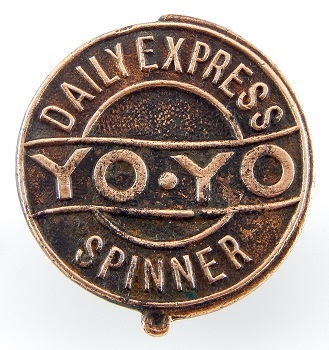|
 |
| Fattorini & Sons, Ltd. Daily Express Yo-Yo Spinner badge |
| Exhibit #4924 |
 |
 |
| Type | Award |
| Condition | Mint |
| Date | 1932 |
| To | 1933 |
| Owner | Rick Brough |
| Compare |  |
|
|
The Daily Express Yo-Yo Spinner badge, circa 1932–1933. The issuer of the badge was the Daily Express, a British national daily newspaper published in London. The maker was Fattorini & Sons Ltd., Bradford House, Birmingham (U.K.). The place of manufacture was Birmingham, England. The material and technique of manufacture was a die-struck coppered brass with a buttonhole fitting on the back (no pin).
During Britain’s early-1930s yo-yo craze, newspapers founded clubs, staged contests, and awarded badges to participants. This lapel badge, reading DAILY EXPRESS / YO•YO / SPINNER, identified its wearer as a competent player and member of the Daily Express yo-yo community. The horizontal "string" bands and rising semicircle suggest a spinning yo-yo.
The reverse has a buttonhole mount that slides into a jacket’s lapel buttonhole, typical of inter-war British club and press badges, and a stamped maker’s mark:
FATTORINI&SONSLTD
BRADFORD HOUSE
BIRMINGHAM
During 1932–33, the United Kingdom experienced a nationwide fad, with department stores and newspapers organizing demonstrations, lessons, and competitions. Badges like this served as membership credentials, prizes, and effective advertising.
The maker, Fattorini & Sons, was a leading Jewellery Quarter firm (a company based in Birmingham's Jewelry Quarter, a historic metal-working and jewelry district of Birmingham, England since the 1800s) that produced medals and club badges for clients all across Britain. Their Bradford House mark helped to date the piece to the inter-war period (between WWI and WWII).
Dating the badge was fairly straightfoward. The combination of the Daily Express promotion, Fattorini’s Bradford House stamp, and the buttonhole style aligns with the U.K. yo-yo boom of 1932–1933, rather than later post-war in which different fittings and suppliers were used.
If you find a similar badge, it's best to retain the original surface; avoid abrasive polishing that would remove the wonderful patina. |  |
| |
|
 |
|
 |
|
|
 |
|
|
 |
 |
|

